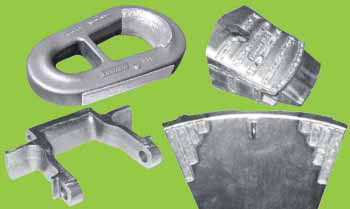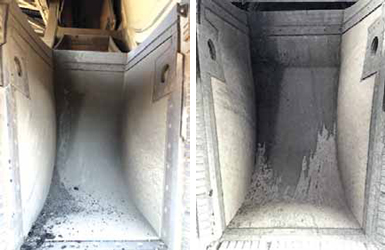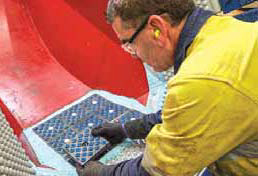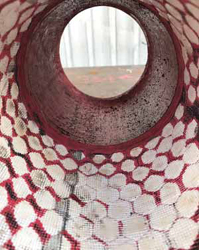
This shovel bucket has been rebuilt with CQMS Razer’s PACplate.
Abrasion-resistant Materials Protect
High-wear Zones
New kit allows miners to prolong replacement times and increase availability
By Steve Fiscor, Editor-in-Chief

More recently, the trays on the haul trucks have attracted attention. Readers might recall the rubber liners announced last year at bauma. This year, the steel industry is responding with solutions that extend equipment life and increase the payload by a few percentage points. The problems, however, don’t end in the pit. High wear areas can be found anywhere along the process stream from the dump point through the crushers. Finding those areas and applying properly engineered products could save an operation from prolonged hours of downtime.
Australian Solutions Applied
in Canada
Across commodities, CQMS Razer (CR)
agrees, seeing a great need for wear protection
on capital equipment exposed to
high abrasion and high impact applications.
This include chutes, crushers, truck
bodies and buckets. The most varied use
of its plate, block and wear products occurs
on excavator buckets. Miners choose
CR’s PACplate solutions and Laminate
wear buttons and bars for their buckets
and equipment because it extends the
service life of the floors and walls, protecting
and reducing wear on the primary
capital equipment. All of the CR’s plate,
block and wear solutions are specifically
designed and strategically placed across
the assets to ensure the life expectancy
of equipment is met.
When it comes to wear, it’s not one size fits all. CR, for example, offers custom- wear package options, based on the mine’s needs and requirements. These can include CR PACplate products as well as high wearing consumables such as Laminite Chocky Bars, Buttons and Skid Bars for additional protection. With the recent acquisition of Berkeley Forge, CR customers now also have access to the field-proven Saberlock Wear Protection solutions including the Saberlock pads, which can be used as an entire wear package for buckets. Recently at an iron ore mine in Western Australia, CR commissioned a PACplate wear package solution on a haul truck tray. The result was an extended tray life that now matches the life of the truck itself. The data gathered on this solution showed a life expectancy of 13 years.
CR recently entered into a collaboration with an independent materials consultancy group based in Vancouver, Canada, to develop a solution for breaker screens at a site in Fort McMurray. This collaboration saw solutions created in Newcastle, Australia, and fitted on a site in Canada. The CR Laminite product was at the core of their breaker screens. Previously, the site had experienced on average 30-days-per-year downtime through maintenance and repairs due to their screens. After the installation of the Laminite breaker screens, the site was able to reduce the downtime to five days per year. The Laminite screens lasted 24 months without the need for any major repairs.
CQMS Razer has also helped customers reduce weight in their buckets from switching their wear packages from a thicker Q&T plate to a harder wearing, thinner overlay plate (PAC Plate), reducing their maintenance and downtime on site, while keeping the structural integrity of the bucket intact. Combining its knowledge and industry experience with Berkeley Forge has delivered fantastic benefits for miners, according to CR. The engineers have worked together to improve the stabilization of the adapter design to reduce lip maintenance. A bucket repair shop recently confirmed that the CR-Berkeley lip required two weeks less maintenance work when compared to other similar products.
CR has been at the forefront of recent developments and digital technology integration in the mining industry including RazerOptics, which enables mine sites to measure wear rates of plate, block and wear on their equipment in real-time. The innovation highlights potential problem areas before they arise and reduces risks of underlying capital equipment being unprotected and damaged. With RazerOptics, operators can use real-time data to predict and schedule replacement of wear products during scheduled downtimes rather than waiting for it to fail and cause unscheduled shutdowns. This innovation has given a new lease of life on wear products and allows us to measure and quantify the value wear products bring to the solution.
Smarter, Lighter Solutions
Using Hardox wear plate and Strenx performance
steel from SSAB, Australia’s Taurus Mining Solutions has managed to
lower the weight of its mining buckets,
increasing the capacity of the buckets by
up to 10% while still keeping their durability.
“It’s a good mix because our idea of
coming up with innovative products was
to have lighter and stronger parts that are
hard-wearing,” said Oliver Sabu, one of
Taurus’s owners.
The result is a mining bucket that
weighs 1 ton less compared to the previous
model. This helps the mines achieve
four-pass loading in truck-shovel applications.
It also means improved bucket life
and decreased downtime. As an example,
a mine site in northern Queensland, Australia,
is currently using a bucket and tray
combination that improves productivity
by 10%-18%.

Some Strenx performance steel is also used in the bucket, at high-stress points such as the hitch and the torque tube areas, to withstand the weight of the bucket and the operational forces of the machine. The use of Hardox and Strenx steels also benefits Taurus’s production process by improved fabrication times and less pre-heating. “When designed right, and processed right, and all the parameters are maintained, the weldability of Hardox is excellent,” Sabu said. “The strength of the material is without comparison, and it’s always consistent, which are the reason we use SSAB steel in our buckets.”
SSAB reported that a couple of mines are planning to rebuild haul truck bodies with a new, tailored Hardox truck bed liner kit in 2020. The kits consist of high-end, high-hardness Hardox grades, including Hardox 450, Hardox 500, Hardox 550 and Hardox 600. Using wear-resistant steel grades in the 550 and 600 Brinell hardness range, such as Hardox 550 and 600, would be a first for the mining business. Using a harder, more consistent steel could reduce the weight of the trays by as much as 5,000 lb. In addition to increasing the payload by 2.5 tons, SSAB believes new kits will extend the service life by 30%-50% (1.5 years) compared to an AR450 liner kit.
Modified Replacement Parts
After extensive development and use in
the field, Columbia Steel offers many of
its replacement parts with Xtend Process
high hardness carbide facing. The
company said its field studies confirmed
that Xtend bi-metallic parts offer significant
advantages in many applications,
which include:
• Increased total wear life;
• Reduction of localized wear;
• Longer maintenance of original profiles;
• Superior performance and production;
• Better metal utilization;
• Reduced downtime of changeouts; and
• Lower cost per ton of material processed.
When its H series martensitic high strength steels are used as the basis for the Xtend process, Columbia said the base casting alloys may range from 286 to 512 Brinell Hardness, with surface hardness up to 700 Brinell Hardness in the high-chromium white iron overlay. When applied to Columbia L and R series of manganese steels, the base alloy will retain its toughness and ductility in the 200 Brinell Hardness area, while the Xtend overlay can be delivered at up to 575 Brinell Hardness with the potential to work harden to an even higher hardness. When the manganese steel is eventually exposed due to wear, it can work harden up to 500 Brinell Hardness depending on the application.

Graphene Wear Liners
After 12 weeks of full-scale trials, a new
wear lining material, developed by First
Graphene and its partner newGen Group,
is demonstrating how graphene is transforming
the properties of conventional rubber products. The graphene-enhanced
rubber wear liners are being tested in
mining shovel buckets at a major iron ore
mine in Australia, where they are being
used alongside standard wear lining materials
to demonstrate the advantages of
graphene additives.
The results after 12 weeks have been
impressive, as Craig McGuckin, managing
director of First Graphene, explained, “Although
the trials are continuing, the initial
results at the half-way stage indicate that
there will be a considerable reduction in
wear rates; we’re estimating an improvement
of at least 100%, which will result in
major cost savings for mine operators.”
The addition of graphene to elastomers
can have a dramatic impact on their
mechanical and physical properties. This
can include, for example, an improvement
of up to 500% in abrasion resistance, an
increase in tensile strength by 40% and
tear strength by around 50%. These enhancements
can be achieved with just a
1% blend of graphene by volume, to the
rubber compound.
Impact Wear Panels
In March 2019, India’s Hindustan Zinc
Ltd. (HZL) confirmed that its installation
of FerroCer liners had completed about
16 months in operation and has withstood
nearly 2.5 million mt of lead-zinc
ore conveyed through the U-13 tripper
chute after the primary crusher at HZL’s
Rampura Agucha mine. In other words,
the mine had experienced precisely
zero wear-panel related downtime in 16
months. That is a significant improvement
on the previous 40-mm-thick manganese
steel liners, which had a life span
of only 23 to 25 days.
Before FLSmidth suggested FerroCer,
one of the challenges HZL faced was the
high wear in the material transfer chutes.
The material handling system needed to
be frequently shutdown so the worn-out
liners could be replaced with new manganese
steel liners, which weighed about 50
kg each. Because of the elevated location
of several chutes, replacement of the liners
required days of safety preparations to
allow workers inside the chutes to handle
the liners.

Ceramic Hose Extends Wear Life
Weir Minerals recently launched its newest
offering in the slurry transportation
space: Linatex ceramic hose. The ceramic
hose combines Linacure rubber with
high-quality, 92% alumina ceramic tiles,
providing a robust option for operators
dealing with abrasive minerals.
Linatex ceramic hose is suitable for
sites handling hard. “It’s the quality of
our rubber that really sets us apart from
the competition, providing superior penetration
of the tile layer and preventing
tiles from dislodging during operation.
To maximize resistance, Linatex
ceramic hose also utilizes hexagonal
tiles, which are more resistant to dislodgment
and wear than traditional
square patterns,” said Rod Dawson, regional
rubber applications manager for
Weir Minerals Australia.
“For a new product to be able to fall under the Linatex brand, it must provide the very best in performance. We’ve put a lot of energy and resources into developing a hose that meets the demands facing miners around the world, and I can’t wait for more customers to see the results for themselves.” Through exhaustive testing, the tile size has been optimized, ensuring they’re large enough to withstand severe abrasion but small enough to reduce cracking.
